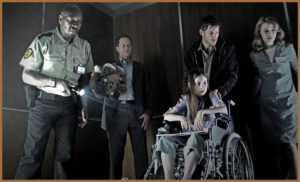Is there anything scarier than a bad autism portrayal? How about one which is SO bad that the idea it’s spreads doesn’t just fracture the public perception of autism, but also seeks to drag our community down to damnation, with only scratch marks to remember us by?
Up to this point, you may not have heard of such a horrifying film. You may not want to believe that such a thing could exist. But, just like the Devil’s greatest trick (in which he convinced the world he was never here), this movie is out there, and its name is Dark Floors.
What the HELL is Dark Floors?

Dark Floors is the first feature film from 2006’s Eurovision winners: Lordi, in which, an autistic daughter, her father and three strangers get stranded on the abandoned floors of a hospital. Only to find themselves running for dear life from a range of different ghouls who want… well, you’ll see.
Yes, this isn’t the most inspired plot you’ve ever heard but, to Dark Floors’ credit, this, at first stale premise, eventually becomes packed full of more paranormal ideas than if the film was written by a ouija board. However, as any kid who eats all their Halloween treats in one mouthful will know, more doesn’t always equate to better and these nifty ideas bloat the film fast.
In interviews following the film’s release, the band have blamed this train wreck on studio interference – in which everything was thrown at the wall and then toned down to attract the Eurovision audience. Nevertheless, this answer only brings more questions ie. how, during the movie’s hurricane of reshoots and rewrites, did no one pick up on the film’s most skin-crawling aspect: its depiction of autism?
A Horrific Depiction (Spoiler-Free)

In many senses, Dark Floors’ depiction of autism blows my mind – not in a good way mind you, but in a sort of Saw-II-beartrap-to-the-head kind of way. This is because, not only is the depiction of autism extremely light in autistic traits but, of those traits lead autistic character Sarah does present with, it makes me wonder whether any of the writers even know what autism is.
Pause the film on any shot and you will probably see a good display of this; from inconsistent obsessions to shutdowns which last seconds. Yet perhaps the biggest culprit of this is the side plot in which Sarah must get to her ‘autism medicine’ by a set time or she’ll die… yep, you read that right, her cause of death will be ‘autism’.
It goes without saying that, within the autistic community, this medicine is as factual as the explanation behind it. However, within the confines of Dark Floors, it demonstrates the reality that, when it comes to autistic depictions, our community is still stuck in the role of an obstacle and, apparently, film writers aren’t beyond making traits up to push this.
Of course, you would hope that this would be Dark Floors’ worst sin but, like a monster who is killed off-screen, only to come back to life later, Dark Floors saves the worst for last.
Dark Floors’ Ending Explained (Spoilers)

So, at the end of Dark Floors it is revealed that non-verbal Sarah was not only aware that the hospital survivors (or at this point survivor) were frozen in time, but that this single moment has played out over and over again. Unable to take this any longer, Sarah confronts her demons and, in a final explosion of light, stands out of her wheelchair and tells the pursuing Lordi ‘No, not anymore!’, before everything goes to black.
In what many have interpreted as a bleak ending, Sarah then wakes up at the start of the film and audiences are left to believe that the nightmare has begun again. HOWEVER, this is far from the end as, in a kind of blink and you’ll miss it moment, it’s revealed that, in overcoming her challenges in the previous cycle, Sarah has started a new ‘heavenly’ path – which can be seen in the different colour crayons and the line spoken by the passing vagrant.
This means that the monsters Sarah has been fighting throughout Dark Floors weren’t creatures from a Devil dimension, nor anything similar. Instead, they were manifestations of Sarah’s difficulties. This means, yep that’s right, in the 2008 horror film Dark Floors, Ex-Eurovision Winners Lordi play the role of ‘Autism’.
There’s obviously a lot to unpack here, but the truly disturbing interpretation of this is that Dark Floors has created a story wherein an autistic person and those around her are stuck in a literal hell because of the condition (and you thought I was joking when I said it was bad.)!
What are the Consequences of Dark Floors’ Dark Flaws?

Of course, there will be those who are saying I should cut the film some slack. After all, it is just an unknown horror flick doing the best it can. But, while no one wants to like Dark Floors as much as I did, it’s important to note that this little-known flick was the most expensive Finnish film to date, with a budget of $4.3 million, as well as a marketing push designed to get as many people as possible to see and hear its message.
As such, Dark Floors and the people behind it demonstrate that, while we have improved our autistic depictions in most mediums, Horror has become, well, horrific for our community, in which our condition continues to be represented as something more deadly than premarital coitus in a Friday 13th Movie.
Thankfully, there is some light at the end of this tunnel and that is that, upon release, Dark Floors was a complete financial flop with an income of just below $800,000, from which it almost immediately fell into obscurity.
Nevertheless, Dark Floors will now and forever remain the skeleton in the closet of autistic depictions and this, more than anything within the actual film, sends chills to the deepest part of me.
Carry on the Conversation
Can you think of a worse autism depiction than Dark Floors? Whether you’re answer is a book, TV show or film, let me know in the comments below. And, if you would like to read more on how autism depictions are developing, then check out this article: Sheldon V Raymond: Have Autism Portrayals Progressed Since 1988?
As always, I can also be found on Twitter @AutismRevised and via my email: AutisticandUnapologetic@gmail.com.
If you like what you have seen on the site today, then show your support by liking the Autistic & Unapologetic Facebook page. Also, don’t forget to sign up to the Autistic & Unapologetic newsletter (found on the sidebar on laptops and underneath if you are reading this via mobile) where I share weekly updates as well as a fascinating fact I have found throughout the week.
Thank you for reading and I will see you next Saturday for more thoughts from across the spectrum.


